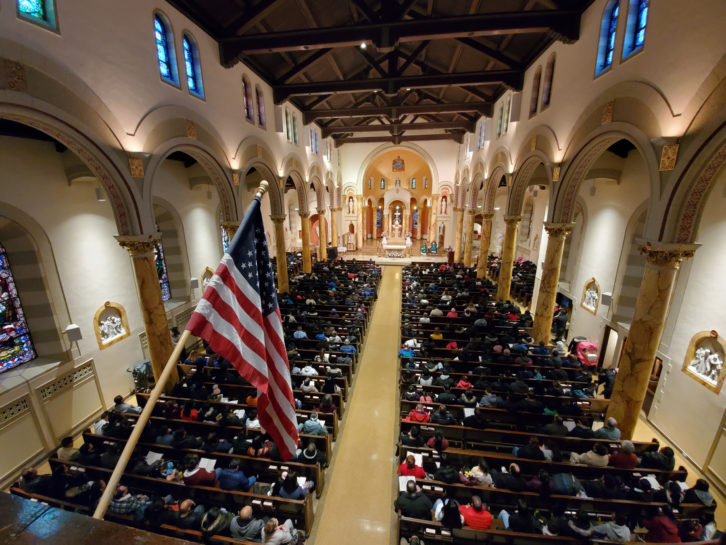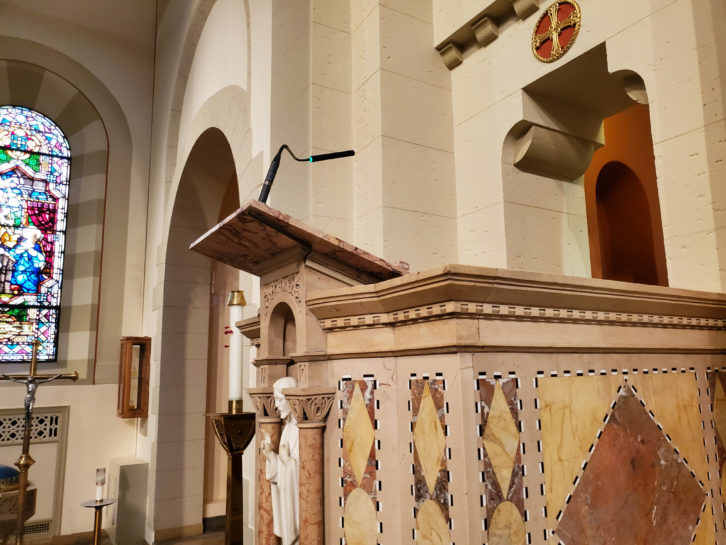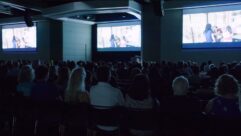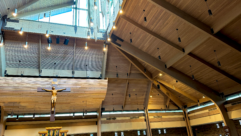 On this edition of the SVC Podcast, Contributing Editor Bennett Liles talks with Steve Minozzi of Monte Brothers Sound Systems in New York regarding the complete sound upgrade at the huge St. Bartholomew’s Church in Elmhurst. The turnkey system is composed of different speaker types and is specially designed to provide clear speech from a wide array of microphone types used in a very reverberant acoustic environment.
On this edition of the SVC Podcast, Contributing Editor Bennett Liles talks with Steve Minozzi of Monte Brothers Sound Systems in New York regarding the complete sound upgrade at the huge St. Bartholomew’s Church in Elmhurst. The turnkey system is composed of different speaker types and is specially designed to provide clear speech from a wide array of microphone types used in a very reverberant acoustic environment.
FOR MORE: GO TO PART 2
- Monte Brothers Sound Systems in Ardsley, NY
- Powersoft Quattrocanali 1204 amplifiers
- Biamp Systems TEC-1 Controller
- Terraspeakers CAM CA 41L line array speakers
TRANSCRIPT:
The largest catholic churches were designed to have lofty reverberation but that can challenge the clarity of speech sound systems. St. Bartholomew’s Church in Elmhurst, New York is one of the biggest around and they called in Monte Brothers to overhaul their system and get the sound right. Steve Minozzi has that story for us coming up on the SVC Podcast.
Steve, great to have you joining us for the SVC Podcast from Monte Brothers Sound Systems. Mainly into churches. You’re based in New York and that’s your primary service area?
We go all over the country, but of course we do a lot of churches in New York City. There’s a lot of people and a lot of churches in New York City. [Timestamp: 0:48]
Well, what’s been going on at Monte Brothers lately? What have you been into there?
Well, as you know we just completed St. Bartholomew’s Church in Elmhurst. Elmhurst is in Queens, which is one of the boroughs of New York City and it’s in the diocese of Brooklyn. And Brooklyn is famous for its big and beautiful churches that were built many, many years back. These churches provide extreme challenges acoustically because there’s nowhere to put treatment on the walls. As you can see from the photos, these are very ornate; almost like museums. So in order for people to hear the spoken word and have good, accurate replication of singing and liturgical music you need to have a sound system that can adapt to these challenging acoustical environments. [Timestamp: 1:41]

Yeah, these places were built to have impressive sounding reverberation and that doesn’t always mix well with electronic sound reinforcement.
No. It’s great for the music program, but it’s tough on the spoken word. And, you know, when these churches were built, believe it or not, the masses were in Latin. And there was not a lot of participation in the sanctuary or predella of a Catholic church, especially everything was done with the priests back to the congregation and he was speaking in Latin and you had missals, etc. etc. Maybe he gave a homely for about three or four minutes through a small PA system that whatever they heard, they heard. But the evolving of houses of worship and the liturgical development that’s occurred with the congregations’ involvement, you have people that are not even professional speakers now speaking at microphone locations in these challenging environments. That was not the way the original church was designed to accommodate. Now it’s highly speech-oriented and intelligibility-oriented. So that metamorphasized into a new use for a building that was designed more for visual enhancement and musical reproduction, etc. So obviously the only way to deal with the needs that have now developed from places with this kind of challenging acoustics is to do it through technology, which is what we do. [Timestamp: 3:15]
And I would think that St. Bartholomew’s is fairly traditional with a pastor, choir and organ.
Yeah. Most denominations, even now even temples have choirs from the congregation. Not only do you have choirs but as you can see from the floor plan we sent you, you have music programs that involve instrumentation, acoustic guitars, there’s acoustic pianos being used. There’s liturgical singing performances from not just the choir loft but from the – in the transepts left and right sides. There’s multiple musical programs going on in that space at the same time besides the spoken word. And this all has to pretty much happen automatically. In other words, the pastor of a church in no way can be manipulating a sound system. They don’t have sound engineers that they hire. These have to operate really in a user-friendly environment. [Timestamp: 4:18]
So it’s pretty much a turnkey system that you had to have in there that anybody can operate.
That’s correct. Pretty much we tell you to leave it on. You don’t even turn it off because we have remote access to monitor the system and in case of emergency we can get in and we can find the problem and fix it from anywhere. One of our service vehicles in another state could get into that church and make an adjustment for them immediately. And we provide 24/7 service, so this is where the houses of worship are going because the time they’re used the most heavily and the biggest attendance is on the weekend; Saturday and Sunday. Not that they don’t use them during the week, but during the week it’s more a funeral or a daily liturgy or a service or a prayer service or a concert. But on the weekend it’s heavily used and it has to perform pretty much automatically because there’s just no time to be manipulating things. [Timestamp; 5:16]

And so what was it about the layout of St. Bartholomew’s church that made it especially challenging for speech clarity?
Well, the biggest challenge in this particular worship space – I mean, they all have their own anomalies. This one, the transepts are almost pseudo-transepts. The transept area in the floor plan that we sent to you is about 20 percent wider than the knave. That’s not typically the case in cruciform religious structures. Typically the transepts are much wider. In this case it’s almost like you have a knave and then you have a wider knave. Now in order to get even sound in all of the areas you need to select speaker profiles that accommodate acoustics by distance. So in the transept – what we’re calling the transept, which we can call the wider knave – we have to use a line array type speaker with a cylindrical wave form. In the knave area, the narrower section more toward the entrance of the worship space, we use a low Q speaker that has a different wave form. And then we have to be able to align these, time alignment by the speed of sound, and by amplitudes we have to create independent zones for each of these banks of speakers so we can balance them out. Because if they’re not balanced you’re not going to understand what people are saying. [Timestamp: 6:49]
And so to make it simple to operate, pretty much push-button without experts needed but behind the scenes it has to be fairly complex to make it simple on the surface. So how did you come up with the control system to do that?
Basically the development of the digital signal processor, which was developed about 20 years ago. We were instrumental in working with Biamp and getting that into the marketplace. And we agreed to field test it, which we did. And we’ve been working with DSP processors – all the companies, many companies now. I mean, we use Biamp because we have a good relationship with them, but the other companies, Symmetrix and Lectrosonics, they all have good products. It’s just a matter of who the contractor is. The DSP processors now are in, I would say, generation four. They’re much more powerful. They have better technology. And so we have the ability to manage sound very, very acutely through our DSP processors; one or two. In this case there’s two. Just more horsepower and more ins and outs. That’s developed significantly from the generation one DSP processors 20 years ago. But that allows us to manage sound in the same way that you buy a car with an automatic transmission. It’s pretty simple. You put it in drive and you step on the gas; and then the brake, hopefully, when you want to stop. On the other hand, when you buy a car with a manual transmission, you have to get involved when you put the car into whatever gear it needs to go into. So the manual transmission is more complicated for the user. The automatic transmission is much simpler for the user. But the automatic transmission is way, way more complicated than the manual transmission. So in this church let’s just put it in plain English. This has an automatic sound system like an automatic transmission in a car. So it does a lot of things automatically. Dynamic range, it has low frequency management, it has all kinds of things going on that the owner doesn’t have to be aware of or doesn’t have to understand. [Timestamp: 9:07]
I noticed that on this project as well as a previous one we talked about on an earlier show you used the Powersoft Quattrocanali 1204 amps. What was the advantage on those?
Well, the problem with amplifiers is you have to have dependability. That’s number one in priorities. I think most contractors would agree if dependability isn’t there it’s not going to happen. So in dealing with Powersoft, we have two reasons why we deal with them. 1. We deal with them because we’re dealing with humans. Not that the other people aren’t humans, but we have direct access to the people in the company. And in the field we have certain situations that come up we need assistance. It’s immediate. Their product is extremely reliable. It’s probably the most reliable amplifier on the market. And it has features in it, you know, it can sense ohmage. It has a lot of different features that accommodate us because in some cases – we don’t use impedance-matching transformers a lot, but in some cases you do. For instance a cry room in a worship space where we are just using basic speakers or outside speakers that can use impedance-matching transformers, the Powersoft will automatically detect that and accommodate that. That’s a big feature for contractors. It eliminates the necessity of us having to go and use and impedance-matching transformer interface on the amplifier, which is another piece of equipment, etc. So there’s a lot of reasons why. I would say dependability and flexibility are the two reasons that the Powersoft amplifier is in our repertoire of equipment. [Timestamp: 10:54]

Of course this is a huge place and a big project. When you put all of this in, did you have to run all new wiring for the speaker system?
Absolutely, yeah. We always run the wire because all of the zones have to be independently wired. We do run foil-shielded, plenum-rated speaker cable even. I know companies tell you don’t do that. You don’t need to do it. We do it. We’ve been doing it for 20 years and we’re going to continue to do it. It’s more expensive and the owner understand that, but we’ve done upgrades in houses of worship. We’re in business 50 years this year, 2019. We’ve upgrades for sound systems that we put in 25 years ago and we’re still able to use speaker cable where it could be used even though we usually have to add more because the designs changed. But yep, it’s all new cable. We don’t rely on cable that’s existing in a worship space. [Timestamp: 11:53]
Great thing to do because even though it may not seem obvious at first, the speaker wiring would be one of the toughest and most time-consuming components to update.
It is. Absolutely. And if you try to use the cable that’s there, and even if it looks like it’s okay, you don’t know if they made splices, if they did them incorrectly, where they made them. You don’t know the integrity of the cable. So therefore we know and we have all the records. If our client calls and says, “This is St. Bartholomew’s Church,” we type in their telephone number and we’ve got everything. We’ve got the type of cable we used, how we did it, where it’s run, what it does. We have all that because we have to run speaker cable, CAT-6 cable. We use Belden microphone cable, the highest quality. We use multicable for all these projects. It has to be all new unless it’s something we did 20 years ago. And if it’s good quality cable and it’s multicable going to a choir loft, you can continue to use it because we know we put it in and we know that it hasn’t been compromised. Of course we test it anyway, but that’s the investment that the owner makes in getting a system from Monte Brothers. It’s designed to last. Today people want improvements. Look at your phone. I just had to get a new phone because my phone was five years old. That’s ancient for a telephone today; for a smart phone. That wasn’t the case. Sound systems don’t last 30 years. People want improvements because things get better and they want that asset applied to a challenging worship space with challenging ambient acoustics. [Timestamp: 13:38]
You might look at the way they do things there and it seems the miking is pretty simple with just a couple of podium mics but they actually use a much wider array of mics than that.
They have wireless mics, they have choir mics. They have a lot of different types of microphones in the system. Acoustic piano microphones. Yeah, it’s not just a podium mic or a pulpit mic, there are different mics that do different things. And they’re in different places. [Timestamp: 14:05]
In Part 2 we’ll get more into exactly how you did the speaker arrays and the monitoring for the choir in the rear balcony. With us today has been Steve Minozzi from Monte Brothers Sound Systems in New York and the sound upgrade project for St. Bartholomew’s Church in Elmhurst. Thanks for being with us today and we’ll see you in Part 2.
Okay.
The right amps and careful speaker placement made all the difference at St. Bartholomew’s. Monte Brothers used a lot of experience and proven gear to get it right the first time. Steve will be back in Part 2 to detail the choir monitoring and system testing. Be back with us to hear about those in the next SVC Podcast.










